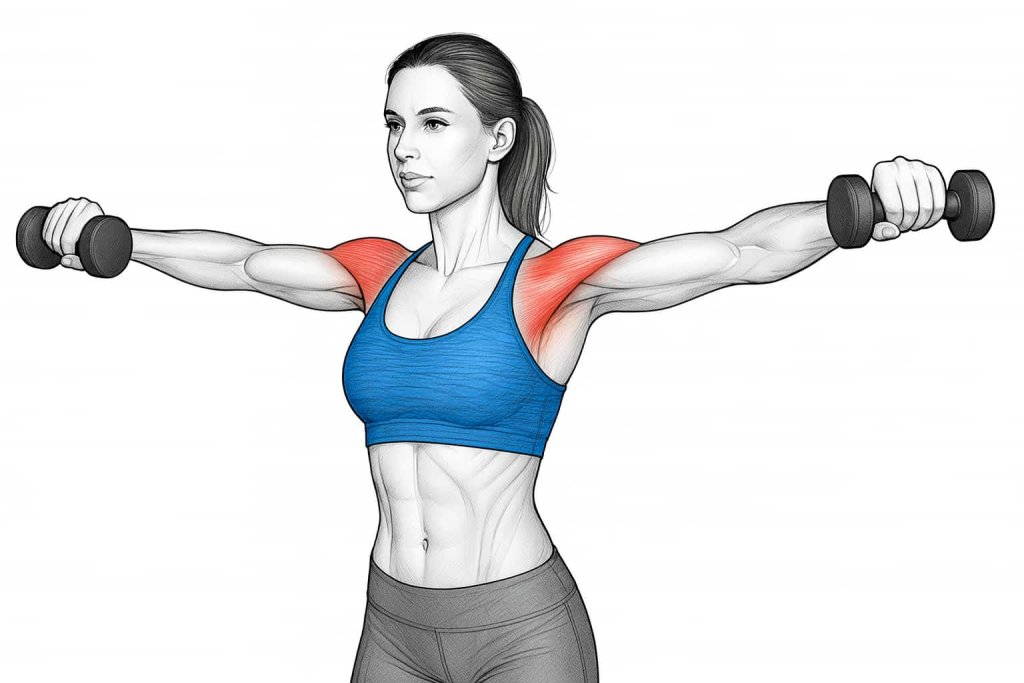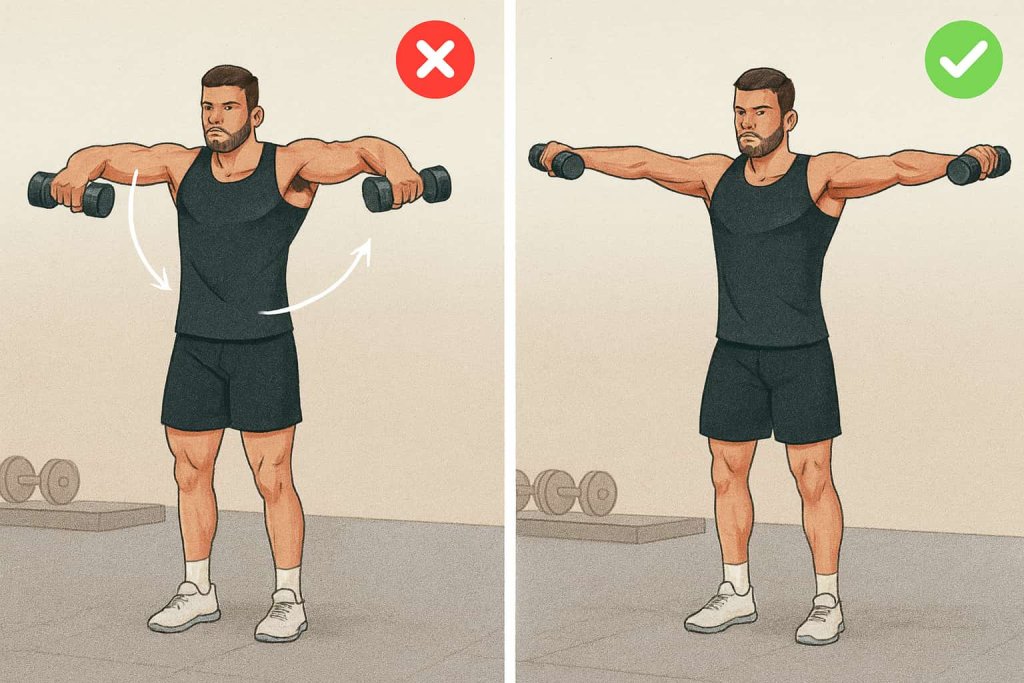Lateral raises are one of the best exercises for building wide, strong, and well-shaped shoulders. The key to a broad, athletic upper body lies in your lateral deltoids—the muscles on the sides of your shoulders that create that “capped” look. Mastering lateral raises can help you achieve better muscle definition, improved strength, and healthier, more resilient shoulders. This guide explains exactly how to do lateral raises with perfect form, the latest science-backed benefits, top variations and alternatives, mistakes to avoid, and expert trainer tips to maximize your results.

Understanding this movement is essential for anyone—from beginners to advanced lifters—who wants to prevent injury, fix muscular imbalances, and get more from their workouts. You’ll also discover recent updates on technique, common questions, and official resources so you can train with confidence and safety.
How to Do Lateral Raises: Step-by-Step Proper Form

Equipment Needed
- Dumbbells: Light to moderate weight (typically 5–15 lbs for most people)
- Optional: Cable machine, resistance bands for variations
Step 1: Setup & Starting Position
- Stand tall, feet about shoulder-width apart.
- Hold a dumbbell in each hand, arms at your sides, palms facing in.
- Engage your core, soften your knees slightly, and retract your shoulder blades (pull them back and down).
- Keep your chest lifted and spine neutral. Avoid arching your lower back.
Step 2: The Raise
- With a slight bend in your elbows (10–20 degrees), lift your arms out to your sides.
- Lead with your elbows, not your hands—your elbows should be higher than your wrists at the top.
- Raise the dumbbells in the scapular plane (slightly forward, about 15–30° in front of your torso). This is a safer and more natural angle for your shoulders (ACE Fitness).
- Stop when your upper arms are parallel to the floor. Do not go above shoulder height; this protects your shoulder joint and keeps tension on the lateral delt.
- At the top, tilt your wrists so your pinky fingers are just above your thumbs—imagine pouring water from a jug. This helps target the side delts better.
Step 3: Lower With Control
- Pause briefly at the top for extra muscle activation.
- Slowly lower the dumbbells back down, resisting gravity. This eccentric (lowering) phase is crucial for muscle growth.
Step 4: Repeat
- Perform 8–15 controlled reps for 2–4 sets, depending on your experience and training goal.
- Breathe out as you lift, inhale as you lower.
Pro Trainer Tips:
- Start lighter than you think! Even advanced lifters rarely use more than 20–25 lbs per hand.
- Imagine reaching your arms “out and away” from your body, not just upward.
- Focus on moving only your arms—avoid swinging, rocking, or using momentum.
Key Benefits of Lateral Raises
- Directly targets the lateral deltoid, responsible for shoulder width and the “capped” look.
- Builds balanced, aesthetic upper-body proportions for men and women.
- Strengthens smaller stabilizer muscles, reducing risk of rotator cuff injuries.
- Supports better posture and movement for sports and daily activities.
- Boosts strength in pressing and overhead movements (like bench press, overhead press, snatch).
- Low-impact; can be performed with light weights, bands, or cables, making it safe for most lifters and even for rehab when done correctly.
Common Mistakes and How to Fix Them
| Mistake | Why It’s a Problem | How to Fix It |
|---|---|---|
| Swinging weights or using momentum | Shifts work from delts to traps; increases injury risk | Use lighter weight, control every rep, pause at top |
| Raising arms above shoulder height | Overloads shoulder joint, strains rotator cuff | Stop when arms are parallel to floor |
| Shrugging shoulders | Activates traps, reduces lateral delt tension | Keep shoulder blades down and back, relax neck |
| Locking or hyperextending elbows | Increases stress on joints, reduces muscle tension | Maintain a soft elbow bend throughout |
| Letting dumbbells fall quickly | Wastes eccentric phase, less muscle growth | Lower slowly (2–3 sec) for full benefit |
| Lifting in the wrong plane (too far forward or backward) | Engages front or rear delt, not the lateral | Lift in the scapular plane (slightly forward, not straight to the side) |
Lateral Raise Variations for All Levels
Lateral raises are a versatile shoulder exercise, and with the right variation, you can tailor the movement to your fitness level, goals, and available equipment. Here’s a complete guide to the most effective lateral raise variations—so you can keep your workouts challenging, fresh, and shoulder-friendly.
Dumbbell Lateral Raise Variations
1. Alternating Lateral Raise
- How to Do It: Stand tall with a dumbbell in each hand, arms at your sides. Lift one arm out to the side while keeping the other down. Lower slowly, then repeat on the opposite arm.
- Benefits: Greater core activation and mental focus, since you stabilize your body while lifting one side at a time. This also allows you to concentrate on each shoulder individually.
- Trainer Tip: Keep your torso still—avoid twisting or leaning.
2. Seated Lateral Raise
- How to Do It: Sit upright on a bench, feet flat. Hold dumbbells at your sides and raise both arms outward to shoulder level, keeping a slight bend in your elbows.
- Benefits: Eliminates momentum and “body swing,” strictly isolating the middle deltoids. Ideal for stricter form and less risk of injury.
- Trainer Tip: Avoid arching your back—sit tall and brace your core.
3. Bent-Arm Lateral Raise
- How to Do It: Hold the dumbbells with elbows bent at 90 degrees. Raise your arms out to the sides, keeping the bend. Lower slowly.
- Benefits: Reduces the length of the lever, making it easier on the shoulder joint and allowing you to use slightly heavier weights.
- Trainer Tip: Don’t let elbows drop below wrist height during the movement.
Cable and Machine Lateral Raise Variations
4. Cable Lateral Raise
- How to Do It: Stand next to a low cable pulley, hold the handle with the hand furthest from the machine. Lift your arm out to the side until shoulder level.
- Benefits: Continuous resistance through the entire range of motion, excellent for muscle activation.
- Trainer Tip: Keep tension in the cable at all times, and control the lowering phase.
5. Single-Arm Cable Raise
- How to Do It: Use the same setup as above but lift one arm at a time. Focus on isolating the working shoulder.
- Benefits: Great for addressing muscle imbalances, improving symmetry, and isolating each deltoid.
- Trainer Tip: Stand tall, and don’t allow the shoulder to shrug upward.
6. Behind-the-Back Cable Raise
- How to Do It: Stand facing away from a low cable. Grasp the handle with the opposite hand behind your back. Raise your arm up and out to the side.
- Benefits: Stretches the deltoid more at the start of the movement, boosting muscle activation.
- Trainer Tip: Use light weights to maintain control—this is an advanced move.
Resistance Band Lateral Raise Variations
7. Band Lateral Raise
- How to Do It: Stand on the center of a resistance band, hold the handles or ends, and raise your arms to shoulder height as you would with dumbbells.
- Benefits: Ideal for home or travel workouts, and the resistance increases as you lift higher.
- Trainer Tip: Keep wrists straight and core tight—band resistance can challenge balance.
8. Pausing or Pulsing Lateral Raise
- How to Do It: At the top of each rep, pause for 2–3 seconds, or add small pulses (mini reps) at the top third of the movement.
- Benefits: Increases time under tension, boosting the “burn” and muscle growth.
- Trainer Tip: Don’t swing—stay in control and focus on squeezing the shoulders.
Advanced or Athletic Lateral Raise Variations
9. Incline Lateral Raise
- How to Do It: Lie sideways on an incline bench, holding a dumbbell in your top hand. Raise your arm straight up to shoulder height, then lower.
- Benefits: Increased range of motion and a unique angle for deltoid activation.
- Trainer Tip: Keep movements slow and controlled, especially when lowering.
10. Lu Raise (Scapular Raise)
- How to Do It: Stand with dumbbells at your sides. Raise both arms out and up, all the way overhead in a wide arc (palms facing forward at the top), then lower.
- Benefits: Works the deltoids through a larger range and emphasizes upper traps and shoulder mobility. Popularized by Chinese weightlifter Lu Xiaojun.
- Trainer Tip: Only attempt if you have healthy shoulders and solid mobility.
How to Choose the Best Lateral Raise Variation
- Beginners: Start with classic or bent-arm dumbbell raises, or resistance bands.
- Intermediate: Try cables for steady tension and seated raises for strict form.
- Advanced: Add incline, single-arm, or Lu raises to your routine for more challenge.
Trainer Tips: How to Maximize Lateral Raise Results
- Train Delts 2–3x/Week: They recover quickly, so moderate frequency helps.
- Time Under Tension: Slow the tempo—2 seconds up, 3 seconds down. Focus on the “burn.”
- Keep Traps Relaxed: If your neck/traps are sore after, lighten the weight and double-check form.
- Progress Slowly: Increase reps or weight by small amounts. Don’t sacrifice form.
- Use Drop Sets: Start heavy, then immediately drop to lighter weights for more reps.
- Mind-Muscle Connection: Visualize your side delts working, not just “moving the dumbbell.”
Alternatives to Lateral Raises
- Overhead Press (Dumbbell/Barbell): Trains delts, triceps, and upper chest.
- Upright Row: Hits lateral delts and upper traps, but use with caution if you have shoulder issues.
- Arnold Press: Rotates dumbbells during the press, working all three deltoid heads.
- Reverse Fly/Rear Delt Raise: Balances your shoulder development by targeting rear delts.
- Front Raise: Complements laterals by working the front of the shoulders.
Tip: Always include a mix of pushing, pulling, and isolation moves for healthy, complete shoulders.
FAQ: Lateral Raises
Q: Should I do lateral raises first or last in my workout?
A: After your heavy presses, but before arm isolation. This ensures your delts aren’t already exhausted.
Q: Are cables or dumbbells better for lateral raises?
A: Both work! Cables offer smoother tension, especially at the bottom. Use both for variety.
Q: Can beginners do lateral raises?
A: Yes—just use very light weights and perfect your form before progressing.
Q: How many sets and reps should I do?
A: Most people benefit from 2–4 sets of 10–15 reps. Focus on form, not just weight.
Q: What if I feel pain during lateral raises?
A: Stop immediately. Check your form and use lighter weights. If pain continues, consult a trainer or physical therapist.
Conclusion
Lateral raises are a must-have exercise for anyone wanting wider, stronger, and healthier shoulders. Focus on strict form, use lighter weights, and avoid the common mistakes that limit results and cause injuries. Experiment with the many variations, keep your routine fresh, and always listen to your body.
